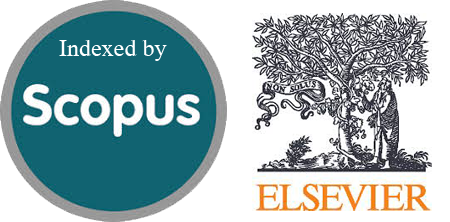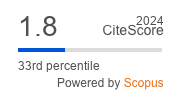Implementation of the Conversational Hybrid Design Model to Improve Usability in the FAQ
Abstract
FAQ is an important part of a system because it is used to make it easier for users to solve problems faced by users. Some FAQ systems have even started using Chatbot technology to make it easier for users. Chatbots have been widely used as a medium for services in almost all fields. Starting from marketing, service systems, education, health, culture and entertainment. Various types of chatbots have sprung up, ranging from text-based like short messaging applications to voice-based ones. However, not all forms of chatbot designs have been successfully implemented in the FAQ system. Adjustments need to be made, especially considering the persona of the user. This research provides a solution by implementing a hybrid conversational design. Hybrid conversation design is accomplished by incorporating text, voice, and buttons into the chatbot interface. Conversation activities with this hybrid interface provide keywords that users may search for in the form of buttons. The hybrid design of the FAQ Chatbot is proven to be able to improve user usability compared to full text chatbots and full text FAQs. The increase in user usability is measured using UEQ, the results of which show an increase in usability from all existing aspects. However, the implementation of this hybrid design also has the consequence that the conversation management system must have structured initial information.
Downloads
References
M. Arain, M. A. Memon, S. Bhatti, and M. Arain, “Feasibility of Chatbot for Mehran UET Examination Department,” Rev. Inf. Eng. Appl., vol. 6, no. 2, pp. 17–28, 2019.
L. Cui, S. Huang, F. Wei, C. Tan, C. Duan, and M. Zhou, “Superagent: A customer service chatbot for E-commerce websites,” ACL 2017 - 55th Annu. Meet. Assoc. Comput. Linguist. Proc. Syst. Demonstr., no. January, pp. 97–102, 2017.
P. Kandpal, K. Jasnani, R. Raut, and S. Bhorge, “Contextual chatbot for healthcare purposes (using deep learning),” Proc. World Conf. Smart Trends Syst. Secur. Sustain. WS4 2020, pp. 625–634, 2020.
S. Valtolina, B. R. Barricelli, and S. Di Gaetano, “Communicability of traditional interfaces VS chatbots in healthcare and smart home domains,” Behav. Inf. Technol., vol. 0, no. 0, pp. 1–25, 2019.
H. Bansal and R. Khan, “A Review Paper on Human Computer Interaction,” Int. J. Adv. Res. Comput. Sci. Softw. Eng., vol. 8, no. 4, p. 53, 2018.
E. Adamopoulou and L. Moussiades, “An Overview of Chatbot Technology,” in arXiv, vol. 584, I. Maglogiannis, L. Iliadis, and E. Pimenidis, Eds. Cham: Springer International Publishing, 2020, pp. 373–383.
S. Kim, J. Lee, and G. Gweon, “Comparing Data from Chatbot and Web Surveys,” CHI 2019 Pap., no. April, pp. 1–12, 2019.
B. R. Ranoliya, N. Raghuwanshi, and S. Singh, “Chatbot for university related FAQs,” 2017 Int. Conf. Adv. Comput. Commun. Informatics, ICACCI 2017, vol. 2017-Janua, pp. 1525–1530, 2017.
R. Berger, M. Ebner, and M. Ebner, “Conception of a conversational interface to provide a guided search of study related data,” Int. J. Emerg. Technol. Learn., vol. 14, no. 7, pp. 37–47, 2019.
M. Jain, P. Kumar, R. Kota, and S. N. Patel, “Evaluating and Informing the Design of Chatbots,” in Proceedings of the 2018 on Designing Interactive Systems Conference 2018 - DIS ’18, 2018.
D. Duijst, J. Sandberg, and D. Buzzo, “Can we Improve the User Experience of Chatbots with Personalisation ?,” Univ. Amsterdam, no. July, 2017.
C. Phillips, “The 3 Types of Chatbots & How to Determine the Right One for Your Needs,” chatbotsmagazine.com, 2018. [Online]. Available: https://chatbotsmagazine.com/the-3-types-of-chatbots-how-to-determine-the-right-one-for-your-needs-a4df8c69ec4c.
Nivethan and S. Sankar, “Sentiment Analysis and Deep Learning Based Chatbot for User Feedback,” in Intelligent Communication Technologies and Virtual Mobile Networks, 2020, pp. 231–237.
A. Trivedi and Z. Thakkar, “Chatbot generation and integration: A review,” Int. J. Adv. Res., vol. 5, no. 2, pp. 1308–1311, 2019.
R. J. Moore, R. Arar, G.-J. Ren, and M. H. Szymanski, “Conversational UX Design,” in Proceedings of the 2017 CHI Conference Extended Abstracts on Human Factors in Computing Systems - CHI EA ’17, 2017.
M. Schrepp, “User Experience Questionnaire Handbook Version 8,” URL https//www. Res. net/publication/303880829_User_Experience_Questionnaire_Handbook_Version_2.(Accessed 02.02. 2017), no. September 2015, pp. 1–15, 2019.
Y. Yua and Q. Xu, “Research on flat design based on UI Design,” Proc. IEEE Asia-Pacific Conf. Image Process. Electron. Comput. IPEC 2021, pp. 423–426, 2021.
Copyright (c) 2022 Jurnal RESTI (Rekayasa Sistem dan Teknologi Informasi)

This work is licensed under a Creative Commons Attribution 4.0 International License.
Copyright in each article belongs to the author
- The author acknowledges that the RESTI Journal (System Engineering and Information Technology) is the first publisher to publish with a license Creative Commons Attribution 4.0 International License.
- Authors can enter writing separately, arrange the non-exclusive distribution of manuscripts that have been published in this journal into other versions (eg sent to the author's institutional repository, publication in a book, etc.), by acknowledging that the manuscript has been published for the first time in the RESTI (Rekayasa Sistem dan Teknologi Informasi) journal ;








